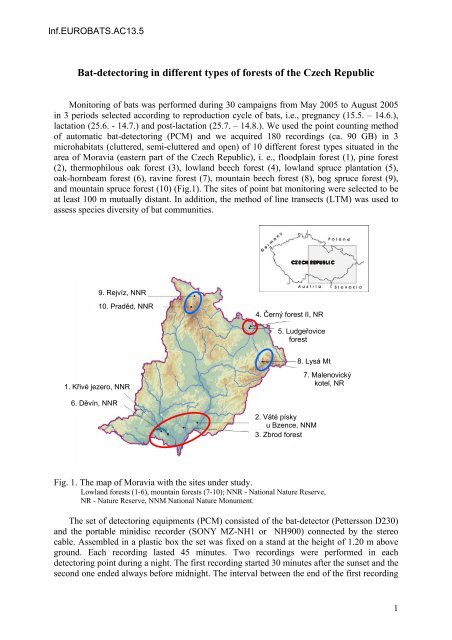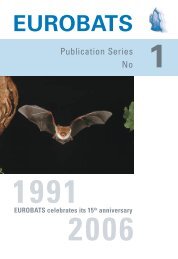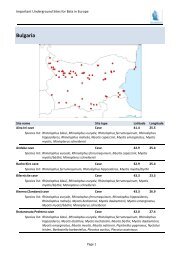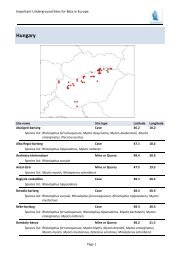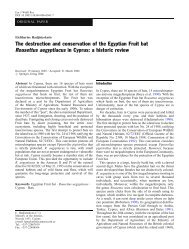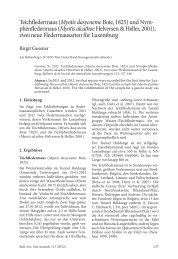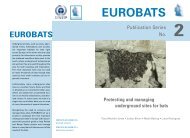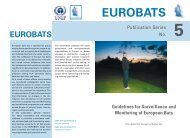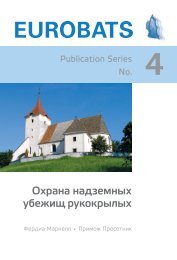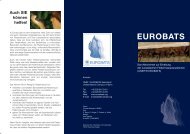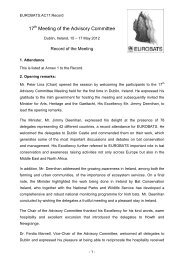AC13.Inf.5 - Eurobats
AC13.Inf.5 - Eurobats
AC13.Inf.5 - Eurobats
Create successful ePaper yourself
Turn your PDF publications into a flip-book with our unique Google optimized e-Paper software.
Bat-detectoring in different types of forests of the Czech Republic<br />
Monitoring of bats was performed during 30 campaigns from May 2005 to August 2005<br />
in 3 periods selected according to reproduction cycle of bats, i.e., pregnancy (15.5. – 14.6.),<br />
lactation (25.6. - 14.7.) and post-lactation (25.7. – 14.8.). We used the point counting method<br />
of automatic bat-detectoring (PCM) and we acquired 180 recordings (ca. 90 GB) in 3<br />
microhabitats (cluttered, semi-cluttered and open) of 10 different forest types situated in the<br />
area of Moravia (eastern part of the Czech Republic), i. e., floodplain forest (1), pine forest<br />
(2), thermophilous oak forest (3), lowland beech forest (4), lowland spruce plantation (5),<br />
oak-hornbeam forest (6), ravine forest (7), mountain beech forest (8), bog spruce forest (9),<br />
and mountain spruce forest (10) (Fig.1). The sites of point bat monitoring were selected to be<br />
at least 100 m mutually distant. In addition, the method of line transects (LTM) was used to<br />
assess species diversity of bat communities.<br />
9. Rejvíz, NNR<br />
10. Praděd, NNR<br />
1. Křivé jezero, NNR<br />
6. Děvín, NNR<br />
4. Černý forest II, NR<br />
5. Ludgeřovice<br />
forest<br />
8. Lysá Mt<br />
2. Váté písky<br />
u Bzence, NNM<br />
3. Zbrod forest<br />
Fig. 1. The map of Moravia with the sites under study.<br />
Lowland forests (1-6), mountain forests (7-10); NNR - National Nature Reserve,<br />
NR - Nature Reserve, NNM National Nature Monument.<br />
7. Malenovický<br />
kotel, NR<br />
The set of detectoring equipments (PCM) consisted of the bat-detector (Pettersson D230)<br />
and the portable minidisc recorder (SONY MZ-NH1 or NH900) connected by the stereo<br />
cable. Assembled in a plastic box the set was fixed on a stand at the height of 1.20 m above<br />
ground. Each recording lasted 45 minutes. Two recordings were performed in each<br />
detectoring point during a night. The first recording started 30 minutes after the sunset and the<br />
second one ended always before midnight. The interval between the end of the first recording<br />
1
and the beginning of the second one was 45 minutes at least and differed in course of the<br />
season due to changes in the night duration. To line transect monitoring (LTM) we used<br />
detectors Pettersson D240x or D980 and recorders SONY DAT TCD-D8 or TDM WM-D6C.<br />
Bat-detectoring on line transects was performed simultaneously with point counting<br />
detectoring and lasted approximately 20 minutes in each of the microhabitats.<br />
All recordings were analysed on the PC using BatSound Pro 3.3.1b software.The level of<br />
flight activity of bats was calculated as the number of minutes when bat calls were listened<br />
(recorded, min+) of total number of minutes of recording (in per cent, %), or per 1 hour of<br />
recording (min+/h). In total, the bats were recorded in 2710 minutes (min+) of 8100 minutes<br />
of all recordings using point counting method (33.5 %) and in 797 min+ of 2296 minutes<br />
during 109 evaluated line transects (35 %), respectively.<br />
Results revealed by the point counting method<br />
The values of the total flight activity of bats in particular forest types amounted to 50<br />
min+/h (floodplain forest, 160 m a.s.l), 35.9 min+/h (oak-horbeam forest, 290 m a.s.l.), 34.7<br />
min+/h (thermophilous oak forest, 170 m a.s.l.), 29.6 min+/h (lowland pine forest, 200 m<br />
a.s.l), 22.4 min+/h (lowland beech forest, 240 m a.s.l.), 19.6 (lowland spruce plantation, 250<br />
m a.s.l.), 3.7 min+/h (peat bog spruce forest, 720 m a.s.l.), 2.4 min+/h (mountain ravine forest,<br />
890-930 m a.s.l.), 1.7 min+/h (mountain beech forest, 940-970 m a.s.l.), 0.7 min+/h (mountain<br />
klimax spruce forest, 1120-1200 m a.s.l.). Fig. 2 shows the variancy of absolute values of<br />
flight activity (min+) in particular forest types (1-10).<br />
60<br />
50<br />
40<br />
30<br />
20<br />
10<br />
0<br />
-10<br />
Median 25%-75% Min-Max<br />
1 2 3 4 5 6 7 8 9 10<br />
Fig. 2. Variancy of the flight activity (min+) in particular forests (1-10).<br />
Red and blue lines – significant differences, y axis – number of min+ (min. 0, max. 45).<br />
The studied floodplain forest significantly differed from other forest habitats by the<br />
highest level of bat activity while bat activity was very low, similar and significantly different<br />
in mountain forests compared to all lowland forests under study.<br />
To evaluate temporal differences in bat activity, forest habitats were lumped in two<br />
groups, e.g. lowland (6) and mountain (4) forests. In the group of lowland forests the bat<br />
activity was significantly highest in the pregnancy period and it gradually decreased towards<br />
2
the end of the season (Fig. 3). On the contrary, bat activity in mountain forests was wellbalanced<br />
throughout the season with the lowest value in the pregnancy period.<br />
50<br />
40<br />
30<br />
20<br />
10<br />
0<br />
Median 25%-75% Min-Max<br />
A B C<br />
Fig.<br />
3. Variancy of the flight activity (min+) in particular periods in lowland forests (1-6).<br />
A – pregnancy, B – lactation, C – post-lactation, y axis – number of min+ (min. 0, max. 45).<br />
In all forest habitats, bat activity was higher at the beginning of a night (1 st quarter of the<br />
night)<br />
compared to the period before midnight (2nd quarter of the night), but not significantly<br />
(Fig. 4).<br />
Fig.<br />
4. Variancy of the flight activity (min+) during a night in all forests (1-10 lumped).<br />
1 - 1 st quarter of the night, 2 - 2 nd quarter of the night, y axis – number of min+ (min. 0, max. 45).<br />
R esults revealed by the line transect method<br />
50<br />
40<br />
30<br />
20<br />
10<br />
0<br />
Median 25%-75% Min-Max<br />
1 2<br />
Species structure of bat assemblages obtained by line transect recordings is shown in Tab.<br />
1. In<br />
total, 13 bat spacies and 2 pairs of species (undisquished by their echolocation calls in<br />
the field) were identified. Occurrence of another two species is unclear. The highest number<br />
3
of bat species (14 at least and except of Eptesicus nilssonii) was recorded in the floodplain<br />
forest. On the contrary, only species was found in the mountain spruce forest.<br />
Tab.1.The list of bat species recorded and their presence in particular forest types (1-10).<br />
Mmys/bra – Myotis mystacinus seu M. brandtii, Mema – M. emarginatus, Mnat – M. nattereri, Mbec – M.<br />
bechsteinii, Mmyo – M. myotis, Mdau – M. daubentonii, Enil – Eptesicus nilssonii, Eser – E. serotinus,<br />
Nnoc – Nyctalus noctula, Nlei – N. leisleri, Ppip – Pipistrellus pipistrellus, Ppyg – P. pygmaeus, Pnat – P.<br />
nathusii, Bbar – Barbastella barbastellus, Paur/aus – Plecotus auritus seu P. austriacus, Hsav – Hypsugo<br />
savii, Nlas – N. lasiopterus; + - presence, +? – unclear presence, S – number of species, Order – order of<br />
the site, Ar – relative abundance (activity) in per cent, site – number of sites, order – order of the species.<br />
Only Pipistrellus pygmaeus seems to be typical lowland bat species recorded at four<br />
localities.<br />
On the other hand, Eptesicus nilssonii can be considered typical mountain species.<br />
It was obtained only at 3 mountain localities, i. e., in the peat bog spruce forest within the<br />
Rejvíz NNR, in the klimax spruce forest below the peak of Praděd Mt. located within NNR of<br />
the same name (both sites are situated in the Jeseníky Protected Landscape Area), and in the<br />
mountain beech forest in the massif of the Lysá hora Mt. (Beskydy PLA).<br />
The study was supported by the grant of Ministry of Environment of the Czech Republic „Bat-detectoring<br />
in different<br />
types of forests of the Czech Republic“ (contact person - mgr. Libuše Vlasáková; EUROBATS), by<br />
the Long-term Research Plan of Ministry of Education, Youth and Sports of the Czech Republic No. MSM<br />
0021622416. We are also obliged to the Agency for Nature Conservation and Landscape Protection of the Czech<br />
Republic (contact person - ing. Jarmila Lančáková, NATURA 2000), the Administration of Protected Landscape<br />
Areas (contact persons – Dušan Duhonský, Jeseníky PLA, mgr. Marie Popelářová-Derková, Beskydy PLA, and<br />
RNDr. Josef Chytil, Ph.D., Pálava PLA) and the Management of Forests of the Czech Republic (contact persons<br />
- ing. Miroslav Sajdl, Forest District, Ostravice, part Malenovice, ing. Vladimír Pešl, Forest District Ostravice,<br />
part Ostravice, ing. Zbyněk Peňáz, Forest District Ostrava, part Šilheřovice).<br />
Doc.<br />
RNDr. Zdeněk Řehák, Ph.D., Mgr. Tomáš Bartonička, Ph.D., Mgr. Jan Zukal, Dr.,<br />
Bc. Petra Simprová and Bc. Žaneta Džingozovová<br />
Department of Botany and Zoology, Faculty of Science, Masaryk<br />
University in Brno (Czech Republic) and Czech<br />
Bat Conservation Trust (Prague, Czech Republic)<br />
4


